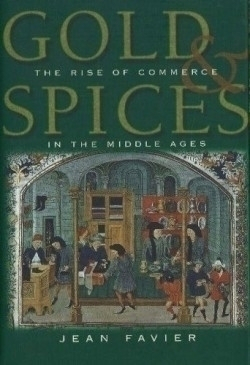Gold & Spices
The Rise of Commerce in the Middle Ages
Beginning in the late fourth century, Gold & Spices gradually takes the reader into the 15th century. The reader is given an excellent glimpse of the lives of peasants, merchants and noblemen alike. All classes of people faced intense challenges with everything from man himself to nature threatening to overturn fortunes. The author deftly shows how the different classes attempted to overcome the challenges, even though their efforts — often as not — led to failure.
Favier shows how the changes in trade and currency led the way to new ideas and systems. Merchants developed from a role of merely selling goods to acquiring the ability to exchange different currencies at the many fairs. They ultimately evolved into what are today’s modern bankers. The upper nobility was dependent on the lower classes for both money and information without either of which a king or prince could easily lose a kingdom. Favier also details how the church and state bartered for both souls and money.
Although Favier generously provides definitions and descriptions, the book seems more geared toward the researcher and historian. The average reader will find some sections of the book somewhat dense and repetitious. A well-rounded bibliography adds to the reader’s quest for information.
Overall, Favier has written an excellent research tool to help readers gain a fresh understanding about the time and life of the medieval era.
Reviewed by
Jennifer Morin
Disclosure: This article is not an endorsement, but a review. The publisher of this book provided free copies of the book to have their book reviewed by a professional reviewer. No fee was paid by the publisher for this review. Foreword Reviews only recommends books that we love. Foreword Magazine, Inc. is disclosing this in accordance with the Federal Trade Commission’s 16 CFR, Part 255.

